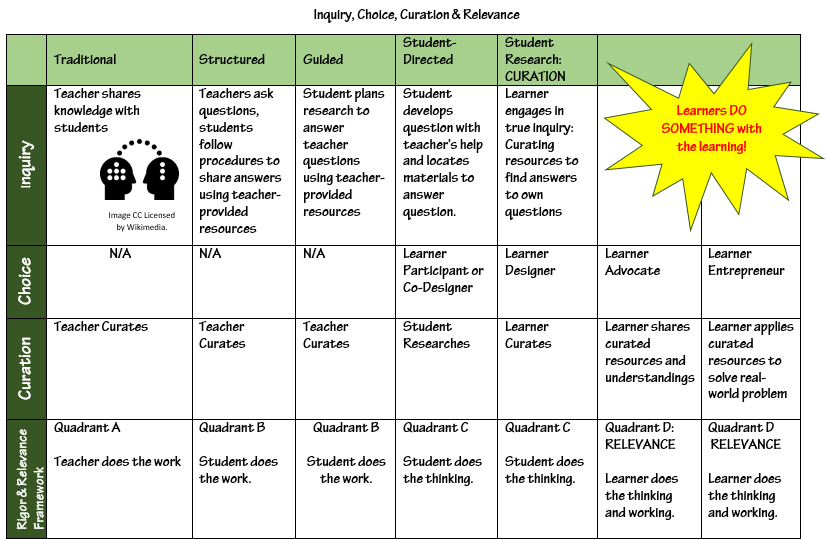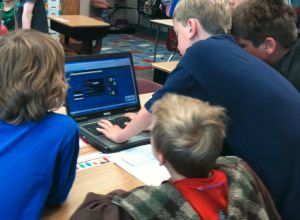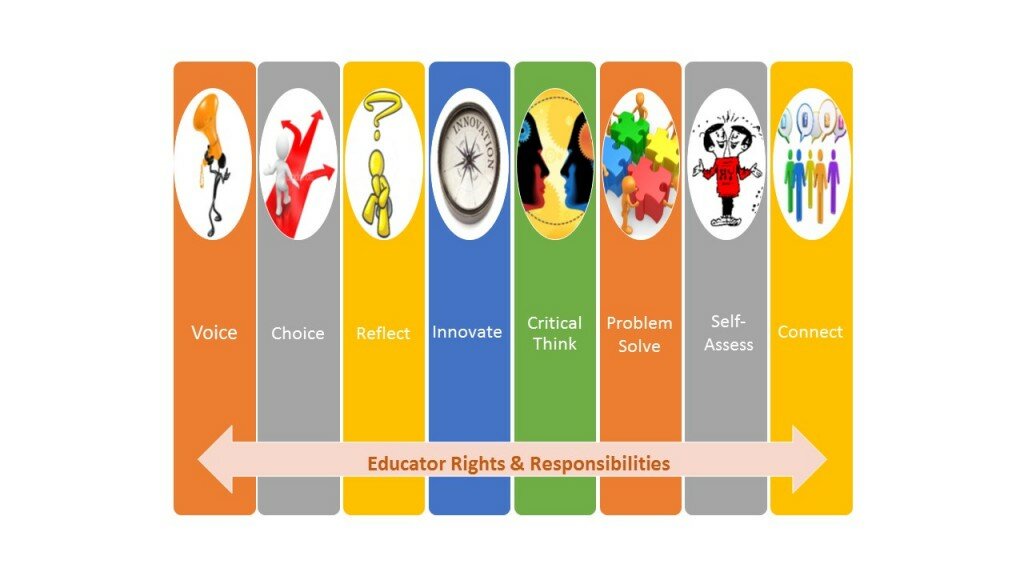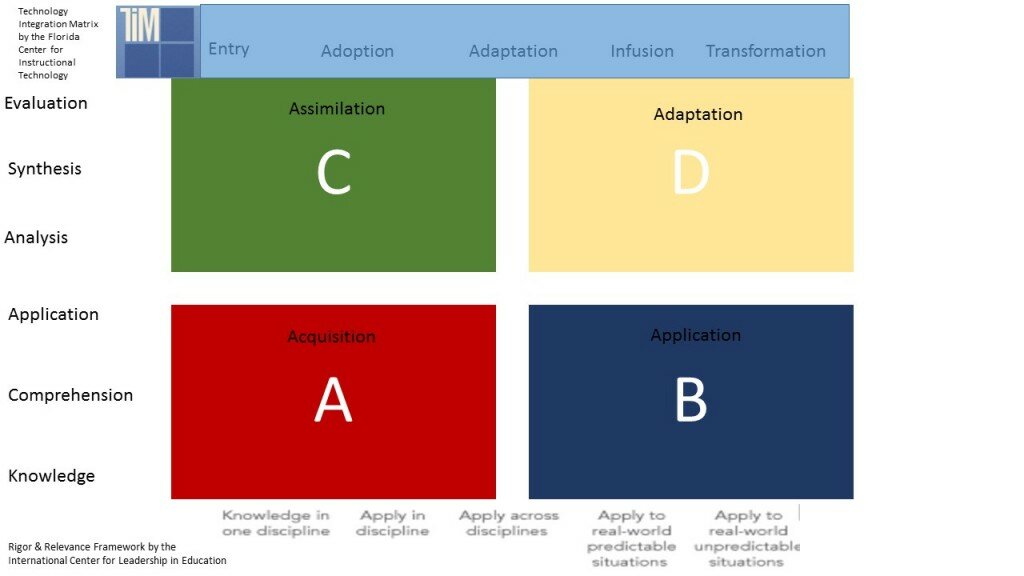Category Archives: Reflection
My Resources and Tweets From #ISTE2016
Teacher-Leader Career Track
 At Colorado ASCD’s ESSA Symposium for Superintendents and district leaders, one particular remark by Dr. Ken Haptonstall, the Superintendent for Garfield School District has stayed with me as I ponder the role of “teacher leader” in a school or district. He said that 70% of his high school teachers have their administrator license, but none of them has any interest in being a principal. At the same event, district leaders were speaking with great concern about the teacher turnover rate. I started wondering: What if we created a program that extended the current Colorado induction program, to provide an ongoing peer coaching program, that could also provided a career ladder for those teachers who want to learn and grow, have an opportunity to advance, but don’t want to leave the classroom? Could developing this address these two needs at once?
At Colorado ASCD’s ESSA Symposium for Superintendents and district leaders, one particular remark by Dr. Ken Haptonstall, the Superintendent for Garfield School District has stayed with me as I ponder the role of “teacher leader” in a school or district. He said that 70% of his high school teachers have their administrator license, but none of them has any interest in being a principal. At the same event, district leaders were speaking with great concern about the teacher turnover rate. I started wondering: What if we created a program that extended the current Colorado induction program, to provide an ongoing peer coaching program, that could also provided a career ladder for those teachers who want to learn and grow, have an opportunity to advance, but don’t want to leave the classroom? Could developing this address these two needs at once?
As I sat in the Symposium, I tweeted my thoughts on this, and received this reply from Lisa Bejarano:
Do we need another degree? Why wouldn’t certification & micro credentials serve this purpose?
— Lisa Bejarano ()
I do think National Board Certification is a fantastic program, however, I see its focus as being on what happens inside of the classroom. The program I envision would be to build teacher-leaders who have additional skill sets that can serve in a leadership role outside of the classroom. What I envision is either a graduate level degree or certification program offered through our state universities that would help develop good classroom teachers into teacher-leaders. The types of coursework might include:
- Cognitive coaching
- Leadership
- Designing professional learning for adults
- State education law
- Privacy law
- Project based Learning
- Personalized Learning
- Technology workflow
- Interpersonal communication
- Digital literacy
- Time management
- Brain-based learning
- Understanding by Design
Teachers who receive this certification could become key voices in district and school development. Here are ideas for these important roles they could assume:
- Mentoring teachers
- Peer Coaching
- Standards alignment work
- Creators of backwards-designed project based learning and units of inquiry
- Writer of common assessments
- Professional learning provider
- Curator of learning materials (digital and print) aligned to standards
- Advisor to school board
Of course, there would need to be some incentive offered by school districts to encourage teachers to participate in this level of career development. Here are some ideas:
- Career Advancement for those who don’t want to be a principal: Promotion – pay scale –higher than teacher +MA – perhaps equivalent to a Dean or Assistant Principal
- Recognition –with all stakeholder groups
- Voice –in state, district and school decision-making
- Paid release time to peer-mentor & coach teachers, design learning and assessments, and curate resources
What are your thoughts? Teachers, would you be interested in a career ladder that allowed you to earn more pay yet remain in the classroom? Administrators, can you see a benefit to having teacher-leaders in your school who can be peer mentors and provide support to teachers who are struggling to transform and build future-ready classrooms?
Transformative Learning
Planning learning with the end in mind is a time-consuming task, but the results are definitely worth it. As a teacher, you have a clear idea of what learners need to understand and be able to do, based on the standards, and hopefully, how those ideas, concepts, and skills apply to the real world so that students are motivated, engaged, and an authentic performance assessment can be planned.
If the learners are able to transfer their knowledge and skills to a new situation to solve a problem or create something new, the teacher can know beyond the shadow of a doubt that the learners truly understand, and will be able to recall that learning and apply it whenever needed. To me, this is innovative, transformational learning – whether technology is used or not. Quite possibly, an authentic task will require the use of technology – as these are real-world tools. But it is not the focal point of the learning.
Recently, I had the opportunity to observe a group of 6th grade science learners engaged in this kind of transformative learning and performance task. The teacher, Laura Murray, had created a unit using Intel Education Transformation Model – a backwards design process. According to the Colorado Science Standards, students need to be able to understand that objects, processes and events are systems that consist of interacting parts, objects and events can be viewed at various scales, and that change follows patterns that can be directional, predictive, and/or cyclic. Students are to learn about the constructive and destructive earth processes.
 Laura’s backwards plan was able to address these understandings and big ideas, and culminated in a performance based assessment where students had the opportunity to apply their understanding in a unique way. Students assumed the role of museum curator –in the far away future. They were able to choose –500,000 or 1,000,000 years in the future! Their task: Create a museum display depicting what the landscape of our area of Colorado might look like in that amount of time.
Laura’s backwards plan was able to address these understandings and big ideas, and culminated in a performance based assessment where students had the opportunity to apply their understanding in a unique way. Students assumed the role of museum curator –in the far away future. They were able to choose –500,000 or 1,000,000 years in the future! Their task: Create a museum display depicting what the landscape of our area of Colorado might look like in that amount of time.
Prior to this culminating event, the students spent a good deal of time studying geologic periods. You can imagine, to the typical 6th grader, this can 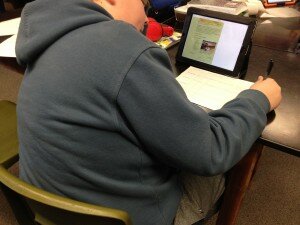 seem very abstract – perhaps even a bit dull. But it really came alive for these learners when Laura introduced them to an online resource provided by the Denver Museum of Nature and Science. They featured a special exhibition on Ancient Denvers: The Denver Basin Project. And –the task that they were given within the role of museum curator was exciting, creative, and engaging. Students had a connection because it was about their own landscape that they were challenged to make a prediction. The students worked in teams to research the exhibits the museum currently offered, read the descriptions, and then used their knowledge and understanding to predict their future landscape. This is a 1:1 iPad school, so they used the iPads to research, draw the landscapes for the exhibit, and write up the description for the museum placard.
seem very abstract – perhaps even a bit dull. But it really came alive for these learners when Laura introduced them to an online resource provided by the Denver Museum of Nature and Science. They featured a special exhibition on Ancient Denvers: The Denver Basin Project. And –the task that they were given within the role of museum curator was exciting, creative, and engaging. Students had a connection because it was about their own landscape that they were challenged to make a prediction. The students worked in teams to research the exhibits the museum currently offered, read the descriptions, and then used their knowledge and understanding to predict their future landscape. This is a 1:1 iPad school, so they used the iPads to research, draw the landscapes for the exhibit, and write up the description for the museum placard.
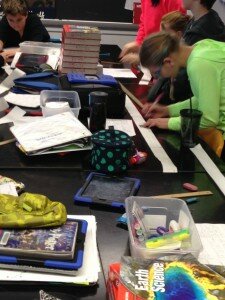 The day I visited, the students were working specifically on their understanding of scale. Students were using rolls of cash register tape to physically see and understand the time distance between the geologic periods. They used a scale of 1 millimeter = 10,000 years and had to mark them all out on the tape. One of the things I loved about this as that Laura chose the best tool for the task at hand. Trying to create these models of scale using the iPad might have resulted in students not being able to see the physical distance from one mark to the next, and reduced understanding as a result.
The day I visited, the students were working specifically on their understanding of scale. Students were using rolls of cash register tape to physically see and understand the time distance between the geologic periods. They used a scale of 1 millimeter = 10,000 years and had to mark them all out on the tape. One of the things I loved about this as that Laura chose the best tool for the task at hand. Trying to create these models of scale using the iPad might have resulted in students not being able to see the physical distance from one mark to the next, and reduced understanding as a result.
What’s next? Seeking authentic feedback from real museum curators at the Denver Museum of Nature & Science. Providing authentic feedback is the finishing embellishment on a unit that provided these 6th grade learners with a transformational learning experience that they may carry with them for a lifetime.

Laura has been teaching middle schoolers for 13 years at Academy District 20’s Challenger Middle School in Colorado Springs. She has taught Science and Social Studies in 6th, 7th, and 8th grade. She has earned Outdoor Recreation, Business, and Curriculum and Instruction degrees from Colorado State University and University of Colorado at Colorado Springs. In her spare time, Laura coaches Forensics, is a NJHS sponsor, and serves on many school and district committees. Laura also volunteers with theater programs at Challenger and Pine Creek High School.
Labels Matter
 The labels that we use matter. At FETC, I was reminded of this when a group of us were treated to a backstage tour of the Polynesian Resort and dinner at the Kona Café. We were escorted around by a “cast member” who made the experience so entertaining and informative. Her commitment to the role she plays is evident. Disney parks are known as magical places – but there are some specific practices put in place to help produce some of the magic that customers experience. One of these practices is the use of the label “cast member.” Think of all that this label implies. A member of the cast, in the traditional sense performs in a show. They create an illusion of another time and place to help transform the experience for those they encounter. This all lends itself to the magic behind the “Magic Kingdom” while communicating some pretty unique expectations to those that serve in the role of cast member, whether they are custodians, servers, or executives.
The labels that we use matter. At FETC, I was reminded of this when a group of us were treated to a backstage tour of the Polynesian Resort and dinner at the Kona Café. We were escorted around by a “cast member” who made the experience so entertaining and informative. Her commitment to the role she plays is evident. Disney parks are known as magical places – but there are some specific practices put in place to help produce some of the magic that customers experience. One of these practices is the use of the label “cast member.” Think of all that this label implies. A member of the cast, in the traditional sense performs in a show. They create an illusion of another time and place to help transform the experience for those they encounter. This all lends itself to the magic behind the “Magic Kingdom” while communicating some pretty unique expectations to those that serve in the role of cast member, whether they are custodians, servers, or executives.
What does all of this have to do with innovations in education? A label we commonly use to refer to our main customer is “student.” Recently, I conducted a book study for a group of forward-thinking educators of Make Learning Personal: The What, Who, WOW, Where and Why by Barbara Bray and Kathleen McClaskey. One idea that resonated with our teachers was a simple shift in language: calling students learners rather than students. This came originally from CAST in the UDL Guidelines 2.0. The thinking behind this is that learning happens everywhere, all of the time. The shift in label from student to learner helps convey this. If we were to list out characteristics of learners and students how would they differ? Below are some of my thoughts. What would you add or change?
And then, in following the #Educon tweets this weekend, this tweet came across my stream:
Calling students “scholars” does not fix the school-to-prison pipeline. You have to treat students as scholars
— Jessica Raleigh ()
This totally reinforces my thinking that our behaviors need to change -simply changing the label is not enough. By changing the label we use for those in our charge, we can begin to see them differently. The relationship changes, which will help them begin the shift from student to learner.
Inquiry, Choice, Curating and Relevance
I continue to work towards connecting the dots between the deep inquiry process that student curation brings, and making learning personal for each student.
Recently, Barbara Bray & Kathleen McClaskey, authors of Make Learning Personal and the most knowledgeable people I know on the topic of personalized learning published a brilliant infographic, illustrated by the amazing Sylvia Duckworth, on “The Continuum of Choice.”
This reminded me immediately of another graphic that depicts the evolution of inquiry – moving control of the learning –or inquiry –from the teacher, to the student, created by Robert Bonnstetter. In an earlier blog post, I speculated that the column furthest to the right demonstrates student curation. I started wondering, where does student choice fall in this process?
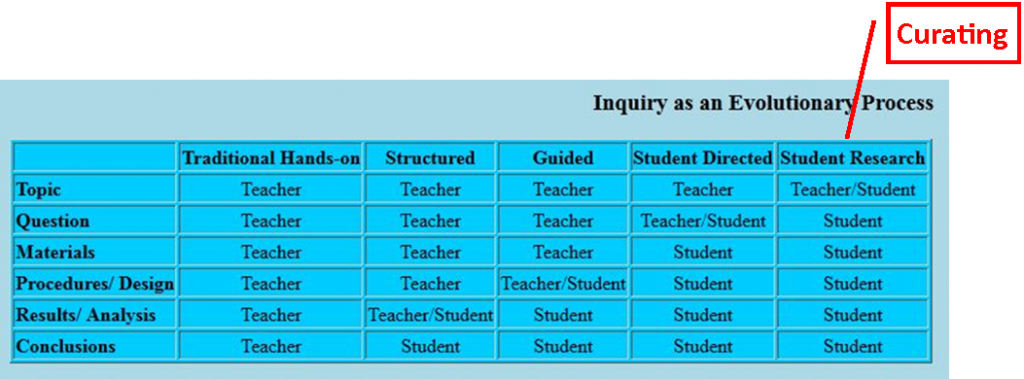
By Ronald J. Bonnstetter: Available http://wolfweb.unr.edu/homepage/jcannon/ejse/bonnstetter.html
While student curation is an important part of transferring ownership of learning to the student, and allows for them to think deeply and make connections as learners, I can see by looking at the “Continuum of Student Choice” that curation is not the final step. We need to provide time and support for our learners to take the next step, and apply the learning and understandings they have reached through the process of curating to solving real world problems, or to create something new.
Because, it’s about the transfer. If we want students to have enduring understanding, and be able to use their learning in practical ways, to solve real world, messy, unstructured problems. We need to provide the opportunity for them to practice this kind of learning transfer in a safe and supported environment.
My Best Hopes for the Future
I serve on our district’s Graduation Guidelines Committee, and recently we were asked to ponder the four questions below as we work on a plan to address new Graduation Guidelines for the state of Colorado. (The views and opinions expressed here are not necessarily those of my district)
We are the custodians of our students’ future. We will assure that students have the needed knowledge and skills for an uncertain future. We are trusted with ensuring that our students know how to learn, have the skills to do so, and we (as a collective group of stakeholders – teachers, parents, administrators, students, higher ed reps, and business reps) understand that the best preparation for an uncertain future emphasizes the learning skills through a different kind of school experience than we have been accustomed to.
Where must we go?
I believe we must re-evaluate the way we teach, or more importantly, the way students learn, and see where we can make changes to assure students are getting the 21st century and workforce readiness skills that they need. Lecture and textbook-based learning do not help students develop these skills. The norm should be students are learning content along the way to solving complex, real-world problems. Students should be the architects of their own learning. There must be support/scaffolding in place for students who will struggle – but we need to increase voice & choice so we can transfer ownership of learning to the student. Teachers need professional training to learn how to design this kind of learning. And technology must be ubiquitously available for all of our students’ learning. Consider – what percentage of time do you think our students will use paper and pencil in their future work? And what percentage of time do they currently use it? If the answer to the second question is larger than the first, then we must do something to balance this. We can impact how they learn – but the future is already rolling out and this is something we have no control over.
What can we allow?
I think we need to allow whatever it takes – but we need to have parent & community support and their understanding of WHY there is a need to change the way we teach and the way students learn. Higher Ed must also be prepared to make some changes as we and other districts are finding a way to move toward a new model of learning.
What do we hope to allow?
I hope we can allow students to have voice & choice in their learning and how they earn a diploma. I hope we can allow students to continuously practice 21st century/workforce readiness skills in pursuit of showing competency in the academic standards, but student paths can all be personalized. Students should be the architects of their learning, because if they are, they will be able to see a real connection between the learning pathways they choose and their higher education and career paths.
Educator Rights & Responsibilities for Future-Ready Students
At the Innovative Education in Colorado (#InnEdCo15) conference, our Leadership preconference featured George Couros, who shared his thinking on transforming classrooms via Sylvia Duckworth’s great infographic. (8 Things to Look for In Today’s Classroom) This got me thinking: What if we applied these 8 things to professional learning and practice for teachers and administrators? As I continued thinking about these 8 things, I began to think of these as not just rights, but also responsibilities if we are ever going to achieve innovation in education and fundamentally transform learning to become relevant for each learner. What would you add to the list?
 Voice
Voice
Teachers and administrators should learn from others and share their learning! Find your voice, get connected via Twitter, present at conferences, in staff meetings, and at parent meetings. Share the exciting learning that is occurring in your school or classroom.
 Choice
Choice
Strength-based learning: Give educators a choice! We understand that technology is opening a pathway to be able to personalize learning for each student. Why not use the same tools and strategies to make professional learning personal for every educator? Offer a blend of online and face-to-face learning. Give educators choice by letting them set personal learning goals and develop a pathway to get there. Provide coaching, support and resources to help them along the way.
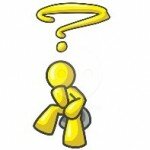 Time for Reflection
Time for Reflection
Everyone can benefit from writing and reflecting on what is being learned. Combine this with “Voice” – and you will make the case to start a blog to share your reflective practice with the world! Model reflection for your students. Be a co-learner.
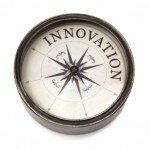 Opportunities for Innovation
Opportunities for Innovation
Administrators: teachers need opportunities for innovation in a safe environment. I’ve made this case on my blog a few times…teacher creativity leads to student creativity. Teachers: Design matters. Be innovative in creating learning experiences for your students that offer them the opportunity to think deeper, create and make connections in pursuit of answers and solutions to real world problems. This doesn’t happen in the factory model of education. Don’t just think outside the box – build a new box!
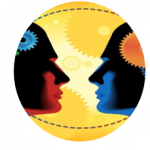 Critical Thinkers
Critical Thinkers
Teachers and administrators should ask questions and challenge what they see. Don’t just do things in education because that’s the way it’s always been done. Times have changed! Challenge the status-quo and seek out opportunities to collaborate and problem solve for each student in your charge.
 Problem-Solvers – Finders
Problem-Solvers – Finders
Teachers and administrators face tough challenges. Merriam-Webster defines innovation as a new idea, device, or method. Find innovative solutions. Embrace the cycle of problem solving where you try, fail, and try again. Model this for your students.
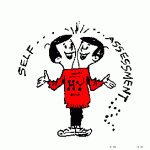 Self-Assessment
Self-Assessment
Self-assessment is formative assessment. It’s part of reflective practice. And, it’s important that teachers and administrators do this. Portfolios can help. And model. And give you voice. And help you connect and grow.
 Connected Learning
Connected Learning
Being a connected educator will make you a better educator. If we hope to be able to help our students safely and effectively navigate social media and the hyper-connected online world, we need to understand it as a participant –and a learner– ourselves. If we hope to keep up with the rapidly growing set of technology tools and strategies for learning, then Twitter is the place to be.
Systematic Approach to Innovation for Learning
One of my primary job responsibilities is helping educators in my district to innovate by providing thought leadership and professional development to get us there. We have embraced University of South Florida’s Technology Integration Matrix (TIM) as a way to help teachers understand the different levels of technology integration, with an eye toward reaching transformation, all while understanding that not all teaching and learning will fall into this category. Much like with the Rigor and Relevance Framework created by the International Center for Leadership in Education, we recognize that learning brand new content often occurs in Quadrant A, or, on the TIM, in the “entry level.” We explain that we hope teachers can increase the frequency of teaching and learning that occurs in Quadrant D of the Rigor & Relevance Framework, or transformative teaching and learning in the TIM. But lately I’ve been wondering, will this get us to innovation? Or, will we have teachers that will be content with the low-hanging fruit – which would be Quadrants A & B, or Entry/Adoption?
The two models are different, in that the TIM focuses on levels of technology integration –the strategy for learning, rather than describing the learning. TIM is all about how the tools are being used – not on the results they produce. It is about inputs. The Rigor & Relevance Framework describes what the students are doing, and the outcome.  As I look at these models and reflect, I wonder if transformation, as described by TIM, is enough for innovation. (See http://d20innovation.d20blogs.org/files/2013/05/Technology-to-Learning-Design-Chart.jpg) For instance, if we are using technology in transformative ways, but it is only for acquisition or application of knowledge, or is limited to one discipline, can we even describe this as transformative, in terms of the impact on the learner?
As I look at these models and reflect, I wonder if transformation, as described by TIM, is enough for innovation. (See http://d20innovation.d20blogs.org/files/2013/05/Technology-to-Learning-Design-Chart.jpg) For instance, if we are using technology in transformative ways, but it is only for acquisition or application of knowledge, or is limited to one discipline, can we even describe this as transformative, in terms of the impact on the learner?
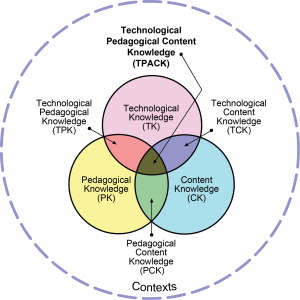 Let’s face it, educational technology departments are stretched pretty thin, and so much of our efforts are still being spent on just trying to get more teachers to use technology. But to obtain the level of innovation that we seek, transformative learning that will prepare our students for an “unimagined future,” a systematic approach is needed, that meets teachers where they are, and consistently moves them forward in both pedagogical and technological knowledge, so that they can achieve the sweet spot described in the TPACK model –Technological, Pedagogical Content Knowledge. We can’t just focus on TIM, because that is only about inputs. To really achieve innovation, I believe we must also use the Rigor and Relevance Framework and backwards design process outlined in Understanding by Design, which includes setting learning goals for transfer.
Let’s face it, educational technology departments are stretched pretty thin, and so much of our efforts are still being spent on just trying to get more teachers to use technology. But to obtain the level of innovation that we seek, transformative learning that will prepare our students for an “unimagined future,” a systematic approach is needed, that meets teachers where they are, and consistently moves them forward in both pedagogical and technological knowledge, so that they can achieve the sweet spot described in the TPACK model –Technological, Pedagogical Content Knowledge. We can’t just focus on TIM, because that is only about inputs. To really achieve innovation, I believe we must also use the Rigor and Relevance Framework and backwards design process outlined in Understanding by Design, which includes setting learning goals for transfer.
Underlying truly meaningful and deeply skilled teaching with technology, TPACK is different from knowledge of all three concepts individually. Instead, TPACK is the basis of effective teaching with technology, requiring an understanding of the representation of concepts using technologies; pedagogical techniques that use technologies in constructive ways to teach content; knowledge of what makes concepts difficult or easy to learn and how technology can help redress some of the problems that students face; knowledge of students’ prior knowledge and theories of epistemology; and knowledge of how technologies can be used to build on existing knowledge to develop new epistemologies or strengthen old ones (Koehler & Mishra, 2009, accessed at http://tpack.org/tpck/index.php?title=Main_Page).
Backwards Planning Professional Development for 1:1
I love the Understanding by Design (UbD) method for planning learning with the end in mind. This makes perfect sense, no matter what you teach – if your goal is to make sure that your students learn. (it’s not enough to say you “taught” it.) In my case, my learners happen to be teachers, and so modeling backwards planning when designing professional learning is essential.
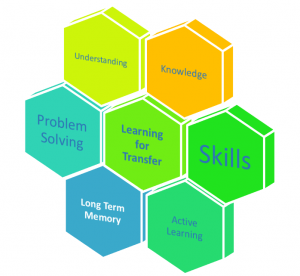 Currently, I am working on a plan for professional learning to support teachers who may pilot 1:1 through BYOD “Bring Your Own Device” in their classes next year. In UbD, Stage 1 involves identifying the learning goals for transfer, understanding, knowledge, and skills, and an overarching essential question that can drive the learning. I love how thinking through these learning goals can spark ideas for the “performance assessment” – which in this case will be the teachers designing learning that is focused on learning goals, and then designing a performance assessment and activities to support those goals – which is where the technology comes into play.
Currently, I am working on a plan for professional learning to support teachers who may pilot 1:1 through BYOD “Bring Your Own Device” in their classes next year. In UbD, Stage 1 involves identifying the learning goals for transfer, understanding, knowledge, and skills, and an overarching essential question that can drive the learning. I love how thinking through these learning goals can spark ideas for the “performance assessment” – which in this case will be the teachers designing learning that is focused on learning goals, and then designing a performance assessment and activities to support those goals – which is where the technology comes into play.
Here are the goals I’ve drafted–what would you add?
Transfer Goal:
Teachers create learning ecosystems that motivate students to own the learning by using technology to support deeper, more personal learning.
Goals for Understanding:
- What is possible to do with technology that could not be done without it
- Understanding how to design learning that motivates learners to take ownership
- Understanding how to give learners voice and choice
- Understand that learning is a social endeavor
- Understand that learner questions and questioning are at the heart of learning
- Understand that real world problem solving motivates learners to reach higher
- Understand that the more they release control, the more students will own the learning
Goals for Knowledge
- Teachers know how to backwards design learning
- Know what it “looks like’ when students are using technology in transformative ways
- Teachers know how to design learning for authentic problem solving
- Teachers know the 21st century skills
- Teachers know how to facilitate, rather than just deliver learning
Goals for Skill
- Basic troubleshooting of devices
- How to use a core group of apps and tools for creating and connecting
- How to model, teach, assess and give students feedback on 21st century skills
Essential Question: How can we make the learning ecosystem meaningful for each individual learner?
« older entries


